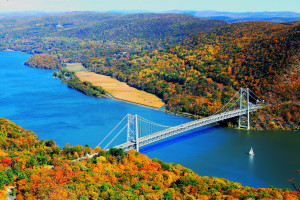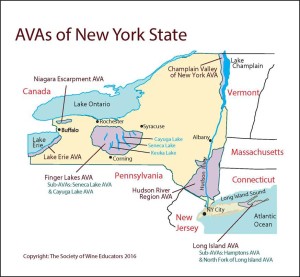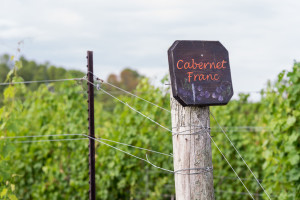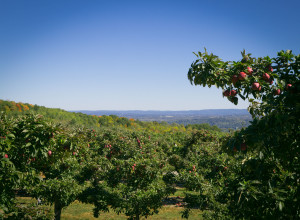Today we have a post from JoAnn DeGaglia, CSW, CS. JoAnn takes us on a journey to New York’s Hudson River Valley and the Hudson River Region AVA.
Eleven thousand years ago the entire northeast coast of the United States, including New York State, was covered by a two-mile-thick sheet of ice known as the Laurentide Ice Sheet. As the glacier melted and receded, it reshaped the land beneath into the beautiful landscape we know today of hills, mountains, and complex, varied soils—a perfect place for grapes, vines, and fruit cultivation.
Part of this landscape includes the Hudson River—one of the great waterways of North America. The Hudson River runs 315 miles from its source at Lake Tear in the Clouds, located in Adirondack Park. The river runs north to south and eventually drains into the Atlantic Ocean between New York City and Jersey City. It is the river’s moderating effect on the area’s continental climate (thanks to tidal flow and winds that sweep upriver from the Atlantic) as well as the “river effect” that makes it possible to grow grapes at all in the Hudson River Valley.
The Hudson River Region AVA (established July 1982) covers an area that extends roughly within the confines of the river valley proper and it includes all or some of several counties: Columbia, Dutchess, Orange, Putnam, Rockland, Sullivan, Ulster, and Westchester. The AVA encompasses 224,000 acres, with about 450 acres planted to wine grapes among 49+ bonded wineries.
The Brotherhood Winery is the oldest winery in the area and the oldest continuously operating winery in the United States. The winery’s earliest first vineyard was planted by William Cornell in 1845 in Ulster County and still exists as part of the Benmarl Winery (located in Marlboro).
The wine making industry in the Hudson Valley has survived war, revolution, blights, extremely challenging weather, and prohibition. This AVA is a survivor and one of the most innovative and diverse areas of viniferous cultivation in the Northeast. The Valley has been known for making great white wines like Seyval Blanc, Chardonnay, and Riesling as well as award winning Sparkling wines.
Much time and effort has gone into finding a Hudson Valley signature red grape. Doug and Mary Ellen Glorie of Glorie Farm Winery, along with Linda Piero and Bob Bedford of Hudson Valley Wine Magazine have established the “Hudson Valley Cabernet Franc Coalition” which is a group of Hudson Valley grape growers, winery owners, winemakers, and supporters that are committed to establishing a Cabernet Franc brand identity for the Hudson River Region.
Hudson River Valley Cabernet Franc is appreciated for its mouthwatering savory, bell pepper-like flavors and medium to high acidity. Cabernet Franc is typically lighter than Cabernet Sauvignon, making a bright pale red wine that adds finesse and lends a peppery perfume when blended with more robust grapes as it is done in Bordeaux.
Given the climate and soil here in our Hudson Valley, it comes as no surprise that Cabernet Franc has emerged as heir apparent for red wine greatness. It’s even been confirmed by science, at Highland, New York’s Hudson Valley Research Lab—a non-profit organization dedicated to supporting research and development for growers in the Hudson Valley. In 2008 Senator William J. Larkin helped to secure funds for the lab to plant a one-acre vineyard with 27 varieties of grapes with the purpose of learning what really grows best in the area. Through these trials, Peter Jentsch, a Research Entomologist and Cornell Cooperative Extension Educator, found that Cabernet Franc kept emerging as the stand out variety.
Cabernet Franc has a significant number of clones which gives growers a range of choices and allows winemakers the ability to combine clonal varieties in order to add complexity to their finished wine—giving each winemaker the ability to truly create their own style of wine using Cabernet Franc.
Recently, the Hudson River Valley has exploded with wineries, distilleries, breweries, and the production of (Hard) Apple Ciders. In our colonial period, apple orchards were plentiful and easier to obtain than grains. As a result, hard cider quickly became one of America’s most popular beverages. The Hudson River Valley area offer great food, beautiful scenery, and delicious local beverages—so it is a great time to visit…and if you already live here, get out and Uncork New York!
JoAnn DeGaglia, CSW, CS teaches wine appreciation classes all over the New York, including the Hudson River Valley. JoAnn’s writings may be found on Facebook on the “The Wine Lovers Journey through the World of Wine” page.
Are you interested in being a guest blogger or a guest SWEbinar presenter for SWE? Click here for more information!



